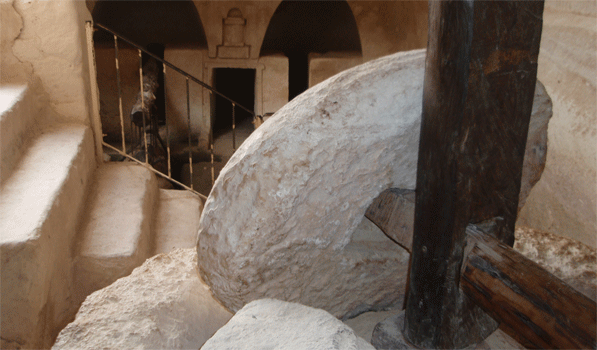(lubavitch.com) Dust the color of a summer blonde on a hillside 40 minutes outside of Jerusalem conceals a secret. Caves carved into soft chalky limestone in Beit Guvrin house an ancient olive oil factory that dates back to the times of the Maccabees.
Within the thick walls of cave, the blazing heat of the day abates. A millstone the size of a shopping cart still stands in the grooved circular rut where olives were once mashed into a dark khaki pulp, a first step in turning the ripe black-red fruit into golden oil.
In the days of the Maccabbees, heroes of the Chanukah festival that began its eight-day run on Dec. 1, a donkey would have been harnessed to power the millstone’s orbit, but even so making oil was slow work. The small jug of oil that was found in the Holy Temple after the Maccabees’ victory had to last for eight days was because it took that long to manufacture and transport oil pure enough for use in the Temple.
Archaeologists have found hundreds of ancient olive oil presses throughout Israel. Submerged off the coast of southern Haifa there’s evidence – deep holes brimming with olive pits – for one that dates back 5,000 years. To this day, Israel remains entwined with olive oil. Her national emblem has two olive-related symbols: olive branches and a oil. Today’s Israeli olive oil makers put generations of know-how to use to produce environmentally conscious oil in the unlikeliest of environments.
The Lubavitcher Rebbe taught that one of the reasons Jewish people are likened to olives is because they yield their best when under duress. Eliezer Toister is a seventh generation olive oil maker whose family is no stranger to pressure. His family grew grapes and produced olive oil in southern Lebanon until 1890 when local Arabs destroyed the press and threatened his great-great-grandparents. Relocating to Safed, and then in 1972, to the Golan Heights, Toister built a rustic, wood-paneled farm for his industrial olive crusher and centrifuge. Though Toister has traded the traditional growing practices in favor of modern techniques, he still bottles the family’s signature blend, a mix of nine varieties.
“Some are sweeter. Some piquant. Each olive type is different, like Jewish people, all special. You need a cocktail of types for an excellent oil.”
Many of Israel’s olive oil producers are based in the Golan Heights. The climate that’s beneficial to the country’s best wines is equally friendly to olives.
“You can cut and paste a lot of vineyard knowledge to growing olives for oil,” said Ehud Soriano, olive oil maker and marketing manager for Eretz Gshur. He lived in Italy to gain certification as an international olive oil taster. There he discovered that the ancient methods of making olive oil “are very romantic, but the oil was poor quality.” Cold pressing their extra virgin olive oil according to variety gives Eretz Geshur cache with Israel’s foodies, like Lehem Erez gourmet bread baker Eretz Komrovsky and Carmela B’Nahala’s chef Daniel Zach.
Eretz Gshur is an environmentally conscious brand. Pomace, olive pulp mash, leftover from oil production is mixed in to feed to nourish the moshav’s cows. Waste water from the press process is captured and used to water the fields.
Last year, Eretz Gshur produced 80 metric tons of oil, a fraction of the estimated16,000 metric tons consumed in Israel each year. Among the nine varieties grown for the Eretz Gshur brand is the Barnea olive. Cultivated by Prof. Shimon Lavee, a researcher with Israel’s Agricultural Research Organization, the Barnea is now grown as far away as Australia plant. The Barnea, a mild, quick growing olive that can be mechanically harvested, also yields its oil relatively easily.
Down in southern Israel, water conditions are a perpetual concern for Halutza, a large-scale olive oil producer in the Negev desert. Located on Kibbutz Revivim, the olive orchards rise up out of the sands like “a beautiful, mini Central park,” said Halutza manager Daniel Esses. Halutza supplies 8-10% of Israel’s locally consumed olive oil and can process 80 tons of olives per day in their on-site mill.
To keep the 100,000 olive trees blooming, Halutza irrigates the trees with the brackish, salty water pumped from deep below the desert sands. This year’s unusually dry weather has allowed Halutza to harvest the ripening olives without delays. “Heat is the issue now. Cold weather gives the trees an extra push to grow,” said Esses. Without cooler temperatures, next year’s harvest may be diminished.
Continued lack of rain will jeopardize next year’s olive crop, but Israel is flowing with olive oil this Chanukah. Grocery stores are promoting discounts on jumbo bottles of oil for purchases over 200 ILS, about 55 USD. Pharmacies stock bottles of olive oil as impulse items at the cash register, alongside the throat lozenges. The ancient source of light lives on in the everyday lives of Israelis today.

Be the first to write a comment.